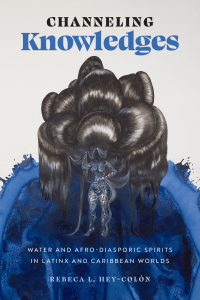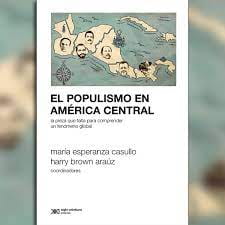A Review of Channeling Knowledges: Water and Afro-Diasporic Spirits in Latinx and Caribbean Worlds
Water is a powerful tenet of Afro-diasporic religions that troubles academic disciplines and racial categories that define state, military and geographic borders. Rebeca Hey-Colón explores the shared histories of Caribbean cosmologies of water in Channeling Knowledges: Water and Afro-Diasporic Spirits and Caribbean Worlds in order to read literature that re-imagines Latinx and Afro-diasporic futures. The characters use anthropocenic knowledge—which refers to the most recent era when humans have begun to impact the climate—in order to petition the orisha-lwa-misterios, or the spirits of nature, to improve their social and material lives. We enter the provocative spiritual and visual worlds of Latina and Caribbean writers Mayra Santos-Febres, Rita Indiana Hernandez and Gloria Anzaldúa, where water acts as a healing, binding and ancestral agent of change.

Channeling Knowledges: Water and Afro-Diasporic Spirits in Latinx and Caribbean Worlds by Rebeca Hey-Colón (University of Texas Press, 2023)
Each chapter draws on three cosmologies Haitian Vodou and Dominican La 21 División, and Cuban Regla de ocha, and focuses on specific bodies of water, rivers and the ocean, that represent political and national borders. I take an unconventional approach to this book review that engages Hey-Colón’s methodological approach to studying water in Afro-Caribbean cultural production. I do so thematically rather by a strict chapter order since as the author notes “This sequence follows neither the delineations of geography nor chronological time because Afro-diasporic waters eschew linear standards of measurement” (23). I take up the thread of analysis about the orisha Yemaya, the mother of the oceans, vital to the water epistemes that probe academic silences about Afro-Latine subjectivities, the climate and migrations throughout the book.
The prologue opens with a discussion about the omission of Haiti-Haitians in The Afro-Latinx Reader by Miriam Jiménez Román and Juan Flores and in Latinx studies (5). In Silencing the Past (1995) by Michel-Rolph Trouillot, historicity or the ways we incorporate the material into social memory, includes Afro-diasporic cosmologies of what cannot be seen, and matters in the production of collective histories and futures. Water and music are both cosmologies of the unseen that are so salient in this text. Considering Haitian identity within the framework of Afrolatinidad traverses cultural, national and linguistic borders. In the Arará or Fon language Afrekete is Yemayá, similar to Agwe and Lasirén—the water spirits of Haitian Vodou. Caribbean sacred music, much like Afro-diasporic notions of water, unveils similarities between Latinx and Caribbean migrations.
The first chapter situates the ocean and Yemayá as a site of crossing and transition in Mayra Santos-Febres’ collection of poems boat people. Various migrants who fled the Duvalier, Trujillo and Batista regimes did so by rafts in the sea—rooted in the political history of U.S. occupation in Haiti, the Dominican Republic and Cuba from 1898 until 1934. The characters’ language creates a visual-sonic landscape where they express their national Caribbean identities. Boat people find their common humanity at sea, rupturing national borders and racial geographies.
This chapter continues by discussing the symbolism of Yemayá in the Cuban balsero (rafters) crisis. Lydia Cabrera and anthropological sources about Regla de ocha creates a rich discussion about the role of water in initiations that represent rebirth and the orishas of the river and seas, las dos aguas, Oshun and Yemaya. Cuban Studies citation practices often omit the voices of Black initiates and intellectuals such as ethnologist-photographer Rómulo Lachatañeré who published Afro-Cuban Myths: Yemayá and other Orishas in 1938, and musician Amelia Pedroso. Their stories contrast with the political upheaval around Elián González during the balsero crisis and affirm that “Santería empowers Latinas, Afro-Cuban, and Cuban women to survive tragedies” (35).
Amelia Pedroso was a queer, Black akpón (ritual singer) and batalera initiated to Yemayá, who grew up in a distinguished family of musician-priests from the working class neighborhood Marianao in Havana, Cuba. A gifted musician, Amelia Pedroso also became the first woman to challenge gender taboos in batá drumming. My padrino (godfather) Liván Nuñez has said that her voice “called the fluidity of the ocha” to Earth—and that visceral, liquid description of Amelia Pedroso’s ability to transmit sacred sound has stayed with me. Afro-Caribbean artist-priests should inform the citation politics of Latinx scholarship along with “…the liquid knowledges of La 21 División and Santería/Regla de Ocha” (82).
In chapter two there is the story of Esther Escudero Omicunlé, a Dominican priestess of Yemayá, preparing to initiate Alcide to Olokun. This ritual is based on the kariocha ceremony where initiates are reborn through what Hey-Colón calls “techno-resonances” or the convergences between cyber technology and ritual. This rich reading of Rita Indiana’s novel La mucama de Omicunlé (2015) focuses on the sexual and gender politics of a Dominican ile, in a futurist world after a series of natural disasters. An ile is a sacred house that serves as gathering place for Lucumí initations and spiritual life. Esther’s spiritual powers fused through cyber power and suboceanic plants refer to Olokun “…the androgynous ruler of unfathomable depths of the ocean in Santería/Regla de Ocha” (58).
Translation plays an important role in interpreting the gender and linguistic fluidity of Yoruba cosmology in Afro-diasporic studies. There is Yoruba vocabulary that the author does not translate, such as Esther’s ocha name Omicunlé. Kunle is the ritual act of saluting an elder related to moforibale, where ori, odo bale means placing ones head in reverence. So Omicunlé could be a person who prostrates or kneels to omi, or surrenders to sacred waters. Perhaps it is this name play that foreshadows the abuses that Acilde faces under Esther’s care: the harrowing moments of sexual assault, concerning power dynamics, financial and ritual exploitation. Rainbow Bright is another techno-resonance “as a life-altering drug that generates a new body…” (70). Acilde’s pursuit of this drug leads to their betrayal of Omicunlé which speaks to the dyanmics of rising initiation costs, the credibility of godparents and exploitation of new initiates that spark online debates about Santería/Regla de ocha.
Acilde as a child of Olokun relates to the androgynous identity of the orisha and the gender fluidity associated with the orishas. They represent the silenced contributions of queer priests who run kitchens for ceremonies, sew clothing for iyawoces, design thrones for los misterios, summon spirit as elegant dancers who embody the divine in step with the drum, singing, calling. Ultimately the act of initiating a person to Olokun is so salient in literature because it does not have a ritual premise in Regla de ocha. Priests designed Olokun’s rituals in Regla and Matanzas so that only certain orishas are crowned. Olokun’s mysterious status and their black geographies are too powerful an energy to crown through kariocha, and divinations would determine if a child of this orisha has a path to priesthood (129).
In chapter three, water corals us to the U.S.-Mexico border identities to grapple with the politics of mestizaje, spiritual currents and anti-black racism within U.S. Latinx communities. Gloria Anzaldúa’s archival papers reveal her relationship with Yemayá as a spiritual mother and literary muse and formed after Anzaldúa had a near death experience where she almost drowned as a child in South Padre Island, Texas (83). Yemayá symbolizes slavery and the history of the sugarcane mill at her sanctuary in Regla on the Havana Bay, that the Siboney called Guacanimar. Anzaldúa’s awareness of Afro-diasporic spirituality ties to Chicanx curanderismo as: “Hegemonic mestizaje’s erasure of African and Asian identities makes Anzaldúa’s mestizaje potentially transgressive because her approach names these absences and places them in conversation with more visible Indigenous and European knowledges” (92).
In the fourth chapter oceans and rivers shape the region just as much as the terrain, where borders are gendered, racialized migrant spaces for Gloria Anzaldúa in Borderlands/La Frontera: The New Mestiza (1987). Several lwa-orisa appear against the backdrop of the Rio Grande/Rio Bravo river: Lasirén, Yemayá, Oyá, Oggun, Ochun, Olokun, Mami Wata, Damballah Wedo, and the first and last energy summoned in ceremonies Eshu/Eleggua or Legba, the owner of the crossroads and messenger to Olodumare (120). In Borderlands Anzaldúa writes about Eleggua and Yemayá in the beginning and ending of the text, implicating both Latinx and Caribbean migrants who cross by water and border crossroads in order to come to the United States (121). Water energetically describes the fluidity of immigration policies, carceral responses and paroles that reinforce political borders for Latinx migrants.
The epilogue documents an action by the Border of Light collective, made up of artists, activists and scholars, in memorial to Haitians and Dominicans of Haitian descent who died in the Parsley massacre of 1937. The book’s ending commemorates the dead through an action lighting candles in 2018 in honor of 20,000 people killed by Rafael Trujillo’s orders at the Massacre River. A bóveda is an ancestral altar with white candles that is usually private, but here served as a public installation of collective remembrance. Ancestral veneration and cemetery water spirits animate Haitian and Dominican cosmologies, which were subjected to violent state suppression on the island. Honoring the collective dead through public memorials strives to heal painfully submerged wounds that ooze beyond borders.
Channeling Knowledges successfully explores Afro-diasporic spirituality in literary worlds that pull us into Olokun’s depths, while it elevates the intellectual, artistic, and activist labor of Latina/x and Caribbean writers.
Jadele McPherson is an artist-scholar completing her dissertation, “Overcoming the Difficulty: The Racial and Gender Politics of Cuban Performance in Tampa and New York City,” historical inquiry into the lives of Afro-Cubans moving from Tampa to New York City. Her research focuses on the intersections of sound healing, mutual aid, and performance in cigar making communities in Florida. She the founder of theater collective Lukumi Arts (2008) where she has created collaborative works based in Black experimental and improvisational lineages that explore healing and embodied memory in the African Diaspora.
Related Articles
A Review of Born in Blood and Fire
The fourth edition of Born in Blood and Fire is a concise yet comprehensive account of the intriguing history of Latin America and will be followed this year by a fifth edition.
A Review of El populismo en América Latina. La pieza que falta para comprender un fenómeno global
In 1946, during a campaign event in Argentina, then-candidate for president Juan Domingo Perón formulated a slogan, “Braden or Perón,” with which he could effectively discredit his opponents and position himself as a defender of national dignity against a foreign power.
A Review of Aaron Copland in Latin America: Music and Cultural Politics
In Aaron Copland in Latin America: Music and Cultural Politics, Carol Hess provides a nuanced exploration of the Brooklyn-born composer and conductor Aaron Copland (1900–1990), who served as a cultural diplomat in Latin America during multiple tours.




